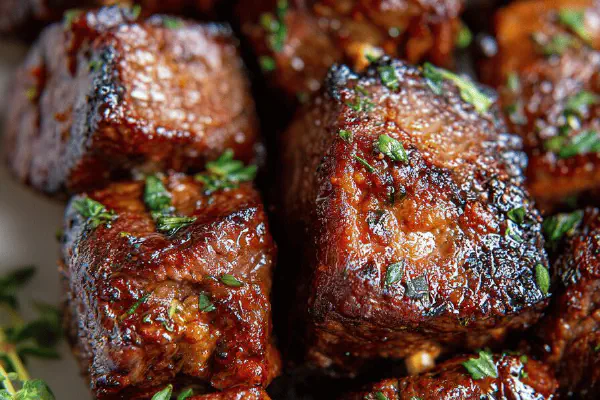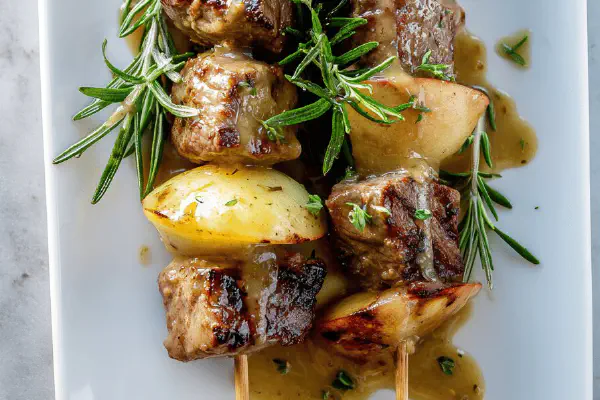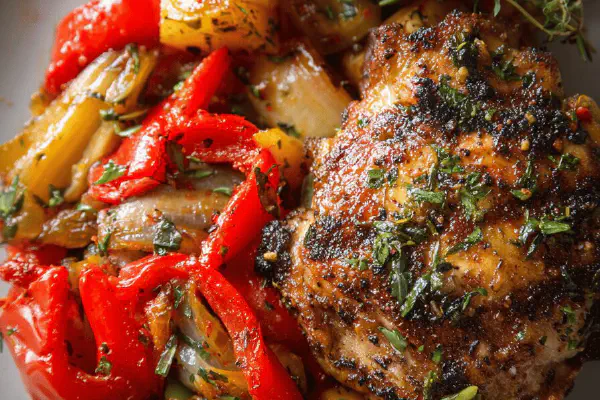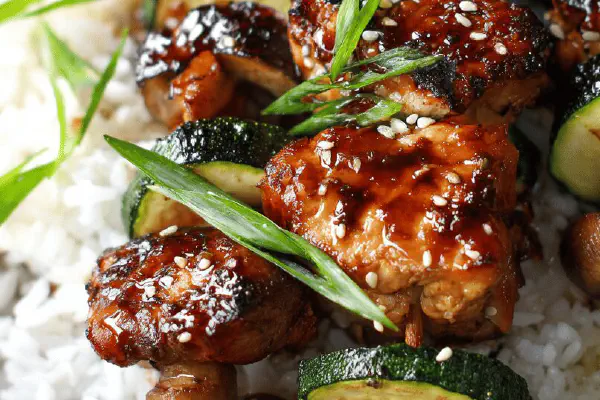Duck and Honey-Glazed Apple Skewers
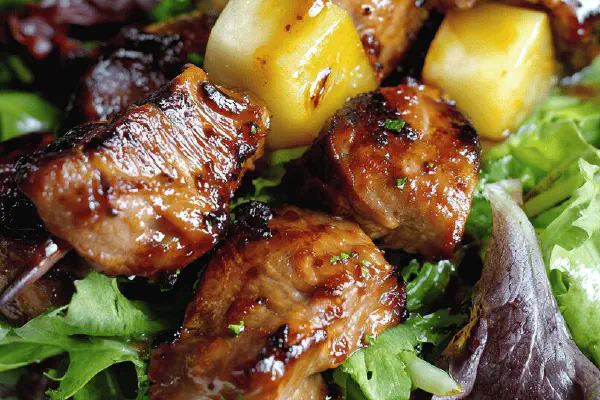
By Emma
Certified Culinary Professional
Ingredients
Honey Glaze
- 120 ml (1/2 cup) honey
- 55 ml (1/4 cup) soy sauce
- 35 ml (2 tbsp) apple cider vinegar
- 1.5 ml (1/3 tsp) ground cinnamon
Skewers
- 2 duck breasts around 340 g (3/4 lb) each, fully trimmed of fat
- 2 Granny Smith apples, cored and cut into 6 pieces each
- 8 wooden skewers soaked 30 minutes or metal skewers
- Salt and freshly ground black pepper
- Olive oil for brushing
About the ingredients
Method
Honey Glaze
- 1. Combine honey, soy sauce, apple cider vinegar, and cinnamon in small saucepan. Bring to vigorous boil over medium-high heat. Stir constantly. Reduce heat; simmer until glaze thickens, around 3 minutes, watching for syrup-like texture. Remove from heat and set aside.
Skewers
- 2. Heat barbecue or grill pan to high. Oil grates well to avoid sticking.
- 3. Slice each duck breast into 8 evenly sized cubes. Alternate threading duck pieces and apple chunks onto skewers. Brush lightly with olive oil. Season liberally with salt and pepper to build flavor into each bite.
- 4. Lower grill or reduce burner to medium heat. Place skewers on grill. Grill 4–5 minutes per side, turning carefully. Start basting with honey glaze immediately and throughout grilling. Watch for duck turning opaque with a hint of pink inside and apples softening with charred spots.
- 5. Remove skewers before meat becomes rigid or apples mushy. Rest 5 minutes off heat to let juices redistribute.
- 6. Serve over crisp green salad with extra honey glaze drizzled on top. Accompany with smoked paprika grilled potatoes for contrast.
Cooking tips
Chef's notes
- 💡 Soaking wooden skewers 30 minutes before grilling avoids flare-ups; water creates steam barrier but metal skewers need cautious handling to avoid burns. Oil grates and skewers lightly; too much oil pools, causing flare-ups and uneven cooking. Keep grill medium heat to prevent sugar in glaze from burning, flames scorch duck skin and harden meat too fast. Flip skewers just once or twice; frequent turning ruins glaze buildup and moisture retention.
- 💡 Cut duck breasts evenly into cubes, about 1 inch for even cook; too small dry out fast, too big stay underdone. Watch duck color shift: from translucent red to opaque light pink signals near-done. Press gently - meat should spring back but not mushy. Apples need to soften with slight char but stay intact. Use smell and sizzle sounds to track glaze caramelizing, bubbling signals thickening.
- 💡 Glaze needs constant stirring while simmering to avoid burning sugars; watch closely once syrup thickens. Honey type affects flavor depth—orange blossom or raw honey add complexity, but standard honey works. Adjust cinnamon carefully; too much overwhelms glaze’s balance. Vinegar brightness critical; apple cider vinegar preferred over white vinegar which is too harsh and kills sweetness.
- 💡 Rest skewers 5 minutes after grilling, juices redistribute preventing dry bites; don’t skip this step. Keep salad crisp and potatoes smoky but not greasy; paprika dusting adds subtle heat contrast to sweet glaze. If glaze thickens too much on cooling, loosen with splash water warmed gently. Salt and pepper generously; layering seasoning throughout builds deep flavor. Use fresh cracked black pepper rather than pre-ground for punch.
- 💡 Grill lid off or slightly ajar to avoid suffocating glaze caramelization but trap enough smoke. Avoid overcrowding skewers; space allows caramelization rather than steaming. Metal skewers conduct heat so cook slightly faster; watch timing. Wooden skewers char edges when flare-ups happen, so manage grill temperature carefully. Brush olive oil lightly to prevent sticking, not gloppy coating.
Common questions
How do I know when duck is done?
Color shift key. From translucent deep red toward opaque light pink. Press with finger; should spring back but still have slight bounce. Too firm means overcooked. Duck cooks fast cubed; use visual and tactile clues over timers.
Can I substitute other apples?
Yes. Granny Smith adds tart snap; Gala or Fuji bring sweetness. If using sweet apples, reduce honey slightly to avoid cloying glaze. Texture varies; firmer apples hold shape better when grilling. Balance acidity and sugar to keep glaze from flopping.
What if glaze burns on grill?
Lower heat fast. Flames scorch sugars quickly. Move skewers to cooler spots or off direct flames. Use moderate heat from start to avoid blackened glaze. Next batch, stir glaze constantly during simmer to keep sugars from burning before applying. Alternative: brush less glaze on first round, add more near end.
How to store leftover glaze?
Refrigerate in sealed container. Thickens cold—gently warm before reuse; add small splash water if too stiff. Can freeze in ice cube trays for small batches. Avoid reheating aggressively; sugars crystallize or burn fast when heated too high.
